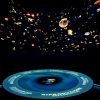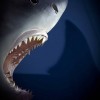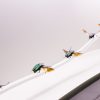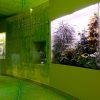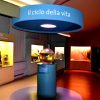Form and function in living things. Present-day and extinct species, inhabitants of waters, lands and the air, gigantic to microscopic in size. A journey in the complexity of living forms, marked by profound differences but also by surprising similarities.
All living creatures share some basic features, such as the capacity to reproduce and that of using external resources as energy and as raw materials to grow. In order to find a partner, food, a suitable place to live, as well as to escape from a predator, organisms have to move, be able to perceive their surroundings and communicate with each other. So unicellular organisms, plants and animals have developed a vast number of adaptations, behaviours and strategies in order to survive. However odd and complex the form of an organism is, it is an evolutionary response to the particular needs of a species in a certain environment. All together these forms, extinct and present-day, gigantic or microscopic, aquatic and terrestrial, constitutes the incredible biodiversity of the planet Earth.
MOVEMENT: living space in a dynamic world
WITHOUT MOVING. Adaptations to feeding and breeding staying motionless. Filter feeders. There are not many animal groups that are able to spend all or most of their life cycle remaining more or less motionless: these are all aquatic organisms that live on the seabed, anchored to floating objects or rocks, which therefore had to devise how to reproduce, defend themselves and reach their food without moving. The difficulties related to motionless feeding were overcome by sponges, bivalve molluscs, sea squirts and other marine invertebrates by making use of filtering structures, which strain the many organic particles present in the water as dissolved or suspended matter. Filtering is such an efficient solution that not only it has been retained over time by many groups of invertebrates, but it has also been adopted by some of the biggest creatures in the world, such as whales. Other sessile animals, like corals, get hold of their food by capturing the particles suspended in the water with their moving tentacles. On the contrary, there are no land animals that live by filtering the air because, compared with water, it is poor in suspended particles, so that air-filtering would be too exacting and not very effective.
WALKING, RUNNING, JUMPING… And other ways to move about on a surface.
Moving on a plane. The capacity to move from one place to another is one of animals’ most obvious characteristics: in this way they can procure food, escape from predators or catch up with a partner to mate. Some unicellular forms or phases of fungi and plants can also move actively, as can some bacteria and other prokaryotes. On land, movements generally take place in two dimensions, since the force of gravity holds the body down onto the ground. Planes of movement, however, are not always horizontal: they are often inclined or even vertical, as on rock walls or trees. Even under water some animals have adapted to bidimensional habitats, like the seabed or the surface of other organisms.
MOVING IN THE WATER. Forms and strategies to swim and float.
Organisms that move about in a fluid, whether air or water, are free to progress in the three dimensions but must fit in with the physical characteristics of the element in which they are immersed. The high density of water has the capacity to keep up the weight of the body, which almost finds itself in a state of absence of gravity, especially in salt water, but at the same time it offers resistance to movement. All swimmers, therefore, have worked out adaptations that enable them to exploit these features, developing hydro-dynamic forms and propulsive structures. The group of organisms most adapted to movement in water is, of course, fish, whose fins, different inshape and position, are specialised organs that provide thrust, regulate direction and allow control. The rear or caudal fin, together with a more or less extensive part of the body, generally provides thrust, while the unpaired dorsal and anal fins have the function of keeping the fish vertical; the paired fins (pectoral and pelvic) act as stabilizers and brakes and are sometimes used for slow, precise manoeuvres.
MOVING IN THE AIR. The conquest of flight.
Most animal species are able to fly. However, in order to keep hovering in the air, substantial adaptations in the body structure and considerable expenditure of energy are required. What are the advantages of flying, then? Moving in the air provides access to food resources and, more generally, to ecological niches that are not available to other animals. It makes it easier to escape from predators or pursue prey more effectively, as well as to use the hind limbs as weapons. The conquest of the aerial space also gives the possibility of moving quickly even between places far apart from each other, overcoming obstacles like mountain chains and stretches of water with relative ease.
NUTRITION: the energy cycle and the strategies to get food
FEEDING ON LIGHT. Photosynthesis at the root of life.
Unique among all living beings, plants build up the organic matter that forms their body from a small number of inorganic substances by means of a process called photosynthesis. An abundant, easily available source of energy is needed to transform simple substances into other complex substances: this is the sun, or rather the part of solar radiation that makes up visible light. This process can only take place thanks to special pigments, the most common of which are chlorophylls, that are present in very simple organisms like bacteria, as well as in more complex ones such as algae, mosses, ferns and all higher plants. During photosynthesis, glucose is produced from water and carbon dioxide, while oxygen is released as a “waste” from the reaction. Indeed, during the history of life on Earth, the percentage of the latter essential element in the atmosphere has increased thanks to photosynthetic activity, initially carried out in microscopic organisms, such as unicellular algae and cyanobacteria, and later on also by terrestrial plants.
VEGETARIAN DIET. Specializations and strategies.
The second link in the food chain consists of vegetable-eaters, the phytophagous organisms, a category that includes not only animals that feed on grass (herbivores) but also those that eat wood, seeds, flowers, fruits and other vegetal tissues. They are the only organisms able to exploit cellulose as food, converting it into substances that can be assimilated. To feed efficiently, phytophagous organisms have adapted in various ways, among which by evolving particular mouth structures. Mammals, for example, share a common dental structure: well developed incisors, canines that are either incisor-shaped or growing smaller until they disappear and massive molars. An extensive diastema, a toothless space where many mammals accumulate the food to be chewed, is often present between incisors and molars. A similar type of mouth architecture is also found in other plant eaters: a gap is recognizable both in the jaws of some insects and in the mouths of ancient vegetarian reptiles, between the incisor-like and the molar-like sections.
EATING OTHER ANIMALS. Adaptation to preying.
Carnivores. The third link in the food chain consists of the predators, organisms that feed by preying on other animals. It may be more laborious for them to procure their food than for plant-eating creatures, but in their favour is the high nutritional value of meat and its easy digestibility. For this reason a carnivore’s body structure, and its dentition in particular, is designed for predation. Among them, several have mouths bristled with sharp teeth, very effective at ripping off pieces of meat that are swallowed whole. This basic pattern, with a wide range of variations, is found, for example, in large preying dinosaurs as well as in present-day mammals, which display a reduction in both teeth number and differentiation. An effective example among invertebrates is the tiger beetles, a group of preying coleopterans. Their jaws, equipped with long pointed teeth, are perfect to pierce their prey on first.
EVERYTHING IS RECYCLED. Nourishment from organic remains.
Decomposers are organisms that feed on dead vegetal tissues and dead animals, breaking down their organic substances. These organisms carry out an essential function, making again available to the vegetal world the simple mineral compounds that were transformed into complex substances along the food chain. A large variety of organisms with different diets and food specialisations belong to the decomposers. They are divided into two groups, which however may merge into each other: while saprophagous organisms feed on animal carcasses and dead plants, coprophagous creatures live on excrements, remains and substances that have already been partly digested. Then, bacteria, acting simultaneously or after such organisms, complete the breakdown of the organic substance into minerals and reintroduce them into the cycle of matter.
